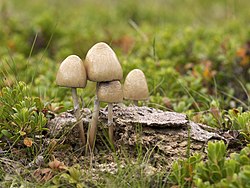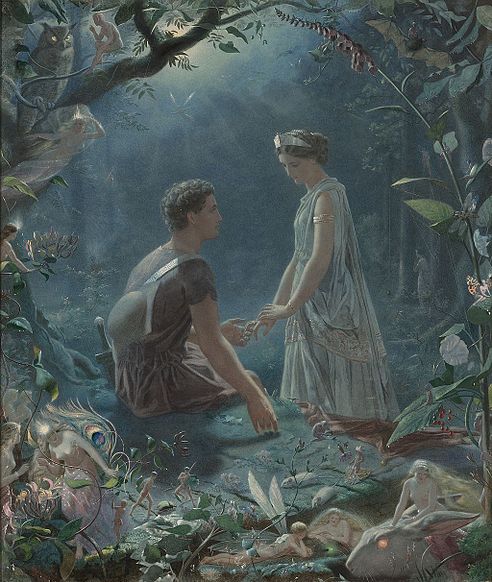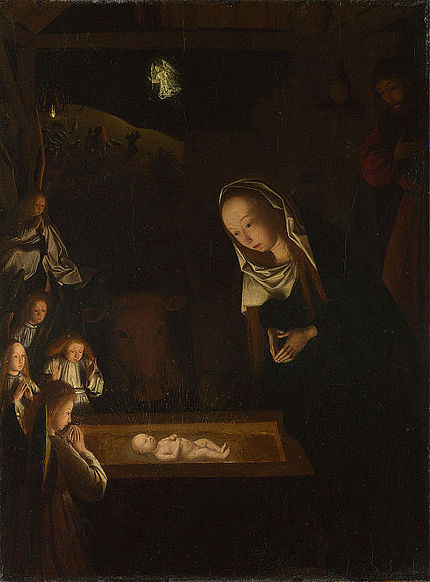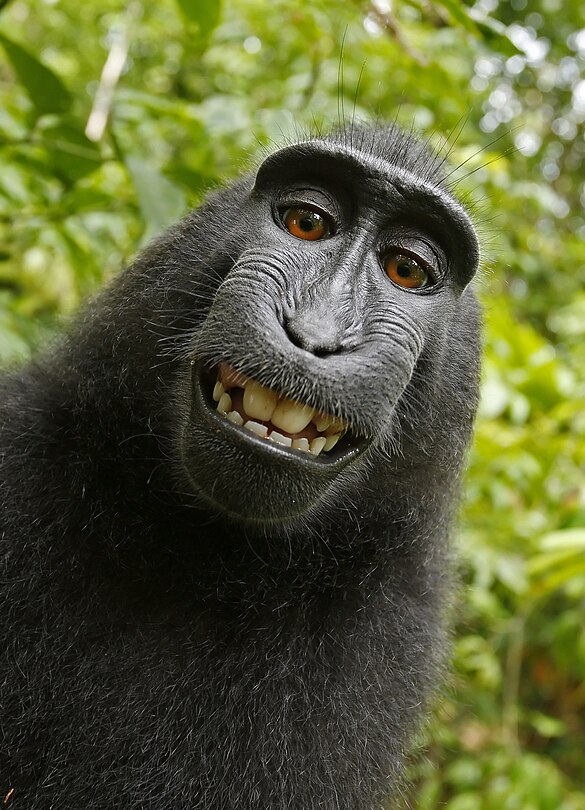Wikipedia:Wikipedia Signpost/2014-12-24/Featured content
Featured content
Still quoting Iolanthe, apparently
- John Simmons' Hermia and Lysander: We are dainty little fairies, ever singing, ever dancing; We indulge in our vagaries in a fashion most entrancing.
- Geertgen tot Sint Jans' Nativity at Night. Unlike most paintings of The Nativity based on the visions of St. Bridget of Sweden, Sint Jans managed to resist the commonly-used layouts that always makes me think they dropped the baby.
This Signpost "featured content" report covers material promoted from 7 to 13 December 2014.
Featured articles
One featured article was promoted this week.

- Hillary Rodham Clinton (nominated by Wasted Time R) It's hard to summarize Hillary Clinton briefly. A native of Chicago, she started in political life in 1960 at age 13, canvassing the South Side for the Republicans. Hillary met Bill when they were both students at Yale Law School in 1971; they married in 1975, but she kept the surname of Rodham so as to keep her separate identity. She became "Mrs. Bill Clinton" in 1982, during her husband's campaign to be re-elected as Governor of Arkansas, "to assuage the concerns of Arkansas voters". During his 1992 Presidential campaign, Bill Clinton claimed that the nation would "get two for the price of one", suggesting that Hillary would assume a prominent role as First Lady. Fulfilling this role from 1993 to 2001, she afterwards promptly became the only First Lady to run for public office – becoming Senator for New York from 2001 to 2009, running for president in 2008, and then becoming Secretary of State in the first term of the Obama administration. Will she become the first female President of the United States? And Bill the First Man in the White House? Only time will tell.
Featured pictures
Fourteen featured pictures were promoted this week.




- Nativity at Night (created by Geertgen tot Sint Jans, nominated by Hafspajen) The Nativity at Night is a tiny little painting, presumably made for private devotional use, that shows the Nativity of Jesus attended by angels, with an inset scene seen through a window of the shepherds on the hillside behind the stable. The angels all look like small Christmas tree decorations. Geertgen tot Sint Jans (c. 1465 – c. 1495), was an Early Netherlandish painter who died probably still in his twenties. This depiction is influenced by the visions of Saint Bridget of Sweden (1303–1373), who was a very popular mystic, and in her vision of this scene the sources of light are the infant Jesus himself. In accordance with Bridget's vision the sole source of illumination in the Bethlehem stable is the Child himself, with secondary sources – the shepherds' fire and the angel floating above them – serving only to illuminate the other part of the scene. Depictions of the Nativity changed significantly in European art following St Bridget's visions of the event, many depictions reduced all other light sources in the scene to emphasize the glowing of the Christ child, and the Nativity remained very commonly painted using the chiaroscuro technique through to the Baroque. Chiaroscuro means the use of strong contrasts between light and dark, usually bold contrasts affecting a whole composition, and also means that you can't really notice the cow and a donkey in the dark, just barely. The painting has a nice pyramidal composition, with the angel on top like a Christmas tree.
- Monkey selfie (created by a literal monkey, yes really, nominated by Chris Woodrich) The monkey selfie is, unsurprisingly, a selfie that was made by a monkey – but what is the copyright for photographs created by animals? Equipment owned by nature photographer David Slater was used by a Celebes crested macaque in Tangkoko Nature Reserve in Indonesia to take a series of self-portraits. The owner of the camera claimed copyright over the image, arguing that he had set up the situation. Other individuals and organizations, however, argued that the photographs, as the work of a non-human animal (and thus not the work of a legal person), were public domain. In any case, we have them now, and our article on the photographs informs us: On August 22, 2014, the United States Copyright Office clarified their rules to explicitly state that items created by a non-human cannot be copyrighted, and lists in their examples a "photograph taken by a monkey", which would appear to reference this case.
- Roque de Agando (created by Diego Delso, nominated by National Names 2000) The Roque de Agando is a prominent rock formation on the island of La Gomera, near the centre of the island, frequently used as a symbol for the island. La Gomera is part of the Canary Islands. The rock is a volcanic plug and is one of the most photographed parts of the island. It is a volcanic landform created by the magma that hardens. If a plug is preserved, erosion may remove the surrounding rock while the erosion-resistant plug remains, producing a distinctive upstanding landform. Roque de Agando is not accessible by foot, hiking is restricted to established paths in its vicinity, as it forms part of a protected area.
- The Crowning with Thorns (created by Caravaggio, nominated by Hafspajen) Jesus, mocked, crowned with thorns in a purple robe as the King of the Jews, is the theme depicted in this painting, The Crowning with Thorns, by Caravaggio. It is all irony; the royal robe and the crown of thorns are statements that actually mean something different from what it was supposed to mean literally. Jesus was not at all the king of the Jews, nor did he ever claim to be. After his condemnation by Pontius Pilate, Jesus was flogged and mocked by Roman soldiers. They clothed him with a scarlet robe symbolizing a royal gown (purple was a royal color), put a crown of thorns on his head symbolizing a royal crown, and put a staff in his hand symbolizing a scepter. They then knelt before him and said, "Hail, king of the Jews!" Maybe Caravaggio felt a certain affinity with the mocked man. Caravaggio was art history's enfant terrible, unorthodox, striking, innovative and rebellious, and also a magnificent painter. He was involved in fights and scandals, and yes he was mocked sometimes – even if he didn't endure it patiently but struck back. Caravaggio had a very special and unmistakable style that was his own, and he influenced generations of painters of the Baroque style like Rubens, Jusepe de Ribera, Bernini, and yes, even Rembrandt.
- Phelsuma grandis (created by Holger Krisp, nominated by Tomer T) Phelsuma grandis is a bright green large day gecko (commonly referred to as the Madagascar giant day gecko), and grows to a length of up to 30.5 centimetres (12.0 in). It is also the biggest day gecko in Madagascar. They live in the trees of tropical forests of northern Madagascar and can also be found in Mauritius. They also inhabit human dwellings and can be found in houses, on verandas and other places around houses. The gecko eats various insects, fruit, pollen and nectar. Like most gecko species, the males are quarrelsome and territorial and will chase away other males in their neighbourhood. They get in one little fight, and their mum gets scared, and says, "You're moving with your auntie and uncl-" Er, I mean, the males only allow females to share the territory they own. Generally day geckos move slowly, but when they are frightened they can move very fast. You can keep them as pets in a terrarium, if you keep them moist and under a lamp and fed them with crickets, wax moths, wax worms, fruit flies, mealworms and houseflies dusted with calcium supplement...
- Panaeolus semiovatus var. semiovatus (created by Jörg Hempel, nominated by Tomer T) The shiny or egghead mottlegill, it grows on horse dung, and is buff-coloured with black spores and brown-to-black gills. It's an edible toadstool, but might cause an upset tummy in some people – or maybe that's the dung talking…
- Hermia and Lysander (created by John Simmons, nominated by Brandmeister) Hermia and Lysander is a watercolour painting by British illustrator and miniature portrait painter John Simmons from 1870 depicting William Shakespeare's A Midsummer Night's Dream. We left our couples from the previous edition, Hermia and Lysander (pictured) and Helena and Demetrius in the enchanted woods at night, quarrelling and confused. Before both guys loved Hermia. Now they both love Helena... It's a bit complicated. It's all the fairies fault! Lysander and Hermia ran away from home to secretly marry each other. They loved each other and all was fine. Helena, who was Hermia's best friend, was engaged to Demetrius, but Helena's fiancé abandoned her to woo Hermia. Demetrius followed after Hermia into the forest, while Helena, who was still in love with Demetrius, followed him. The fairies try to help, but make a mess of everything. Therefore, the boys, who were both in love with Hermia, now are both in love with Helena all of a sudden, chasing after her, while Hermia runs furiously after them all. Helena is mad and accuses Hermia of being part of a cruel joke, making fun of her and mocking her. Some girls are like that. Hermia feels betrayed by the accusation and retorts that she would never hurt her friend that way. Does this remind you of a soap-opera? Well, maybe... but a classy one. The fairies, unfortunately, do not do the obvious next mistaken step, so we don't get to see Lysander and Demetrius make out on stage, but they do fix everything and all find their loves again: Happy ending! Lysander loves Hermia and Demetrius loves Helena once more.
- Japanese Occupation currency of the Netherlands Indies (now Indonesia), 1942 series: One cent, five cent, ten cent, one-half gulden, one gulden, five gulden, and ten gulden (created by Empire of Japan, nominated, scanned, and prepared by Godot13) In December 1941, the Empire of Japan began the Battle of Borneo (1941–42) on Borneo, and those parts of the island which were part of the Dutch East Indies. The Dutch colonial government capitulated on 8 March 1942, and the Japanese government assumed control of the Indies' economy, closing the existing banks, and began issuing military banknotes for use in the occupied Indies: banknotes printed in Japan, and issued by the Japanese Ministry of Finance. This issue formally retained the gulden name, though it was nicknamed oeang pisang or banana money, for the prominent bananas on the ten gulden note. The Japanese forces surrendered on 15 August, and two days later the Republic of Indonesia proclaimed its independence. In March 1946, Dutch-controlled areas replaced the Japanese-issue roepiah. The Indonesian Minister of Finance, Alexander Andries Maramis, estimated in 1946 that the Japanese had put some 2.2 billion roepiah into circulation by the end of the occupation.
- Our last fairy
|






Discuss this story